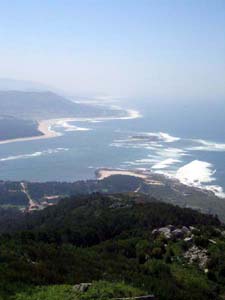


|

|
| Miño entrance from Monte Tecla | A Guarda from Monte Tecla |
To get to the entrance at the right time, you either have to navigate at a predictable speed for the 15-odd miles from Baiona to the North or Viana do Costello to the South, or stay overnight in A Guarda, about 3 miles away. A Guarda is a delightful working fishing village with a safe, if slightly uncomfortable harbour. However, there are no visitors' buoys, and there is nowhere to anchor, so you have to negotiate, with no guarantee of success. We were lucky, finding another catamaran on a buoy whose crew assured us that a nearby buoy was free for the night. If we hadn't been lucky we'd have had to continue to Viana do Costello.

|

|
| Miño upriver from Monte Tecla | Roman village on Monte Tecla |
There are 3 bridges. We estimated the new bridge at Goián/Vila Nova de Cervereira as being over 20m clearance. We did this by anchoring just below, taking the dinghy to one of the piers and measuring the height of its base with a tape measure. We then used the sextant to assess that the rest of the pier was about 10 times greater, and guessed that the arch of the span added another 2 metres. In fact, as we learned later, the clearance in the centre of the spans is 25m. There are a further 2 bridges just below Tui, the second known to be 15m above high water, and the first being 25m. The local who gave us the measurements kept a yacht in Tui with a 16m mast! So, he could only come and go below half tide, and had real evidence to prove the bridge height. About a mile above Tui, there are some "almost rapids", which are really only passable in a speed boat.